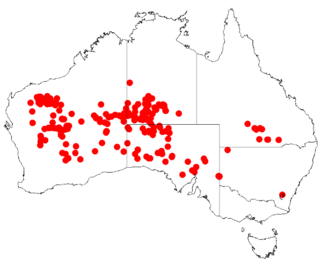
Acacia aneura, commonly known as mulga or true mulga, is a shrub or small tree native to arid outback areas of Australia. It is the dominant tree in the habitat that it gives its name to (mulga) that occurs across much of inland Australia. Specific regions have been designated the Western Australian mulga shrublands in Western Australia and Mulga Lands in Queensland.

Acacia ligulata is a species of Acacia, a dense shrub widespread in all states of mainland Australia. It is not considered rare or endangered.

Acacia colei is a perennial bush or tree native to northern Australia and southern Asia. A common name for it is Cole's wattle. Acacia colei blooms from May through September and the flowers are bright yellow.

Acacia ayersiana is a plant that grows in arid areas of Australia.

Acacia cana, or commonly named as boree or the cabbage-tree wattle or broad-leaved nealie, is part of the family Fabaceae and sub-family Mimosoideae. It is a dense shrub- tree that can grow to 6 metres (20 ft) high and is a perennial plant meaning it has long life span and doesn’t necessary produce a high amount of seed. The cabbage-tree wattle heavily flowers from August till October and relies on animals and insects for pollination and dispersal of seeds. This least concern acacia species is found in the western plains of New South Wales and Central Queensland the habitats of these areas are found to be sandy soils and gibber plains.

Acacia applanata, also known as golden grass wattle or grass wattle, is a grasslike shrub belonging to the genus Acacia and subgenus Alatae. It is native to the south west of Western Australia.

Acacia aptaneura, commonly known as slender mulga, is a shrub belonging to the genus Acacia and the subgenus Juliflorae. It is native to central and western parts of Australia.

Acacia caesaneura, commonly known as western blue mulga, is a shrub or tree belonging to the genus Acacia and the subgenus Juliflorae that is endemic to western Australia.

Acacia mulganeura, commonly known as milky mulga and hilltop mulga, is a tree or shrub belonging to the genus Acacia and the subgenus Juliflorae that is endemic to arid parts of central and western Australia.

Acacia paraneura, commonly known as weeping mulga, is a tree or shrub belonging to the genus Acacia and the subgenus Juliflorae. It is native to arid regions of Australia. The Indigenous Kurrama peoples know the tree as warlun.

Acacia ramulosa, commonly known as horse mulga or bowgada wattle, is a shrub belonging to the genus Acacia and the subgenus Juliflorae endemic to arid areas of Australia.

Acacia rhodophloia, commonly known as minni ritchi or western red mulga, is a tree or shrub belonging to the genus Acacia and the subgenus Juliflorae that is endemic to a large area of arid central western Australia. The Indigenous group the Kurrama peoples know the plant as mantaru.

Acacia tenuissima, commonly known as narrow-leaved wattle, broom wattle, minyana, slender mulga or slender wattle, is a shrub belonging to the genus Acacia and the subgenus Juliflorae endemic to temperate and tropical areas of Australia. Indigenous Australians the Kurrama peoples know the plant as Janangungu and the Banyjima know it as Murruthurru.

Acacia littorea, also known as the shark tooth wattle, is a shrub belonging to the genus Acacia and the subgenus Phyllodineae.

Acacia calcicola is a shrub or tree of the genus Acacia and the subgenus Plurinerves that is native to parts of central Australia. Common names for this species include; shrubby wattle, shrubby mulga, myall-gidgee, northern myall and grey myall. Indigenous Australians the Pitjantjatjara peoples know the tree as ikatuka, the Warlpiri know it as jirlarti and the Arrernte know it as irrakwetye.

Acacia oswaldii, commonly known as boree, umbrella wattle, umbrella bush, whyacka, middia, miljee, nella and curly yarran, is a shrub or tree of the genus Acacia and the subgenus Plurinerves.

Acacia pentadenia, commonly known as karri wattle, is a shrub or tree of the genus Acacia and the subgenus Pulchellae.

Acacia macdonnelliensis, commonly known as the MacDonnell mulga and the Hill mulga, is a species of Acacia native to central Australia. The Indigenous Australians the Alyawarr peoples know the plant as irrar, the Kaytetye know it as arleth-arlethe or arwele arleth-arlethe and the Western Arrernte peoples know it as irrkwarteke.
Mulga is a type of habitat composed of woodland or open forest dominated by the tree mulga, Acacia aneura, or similar species of Acacia.


















